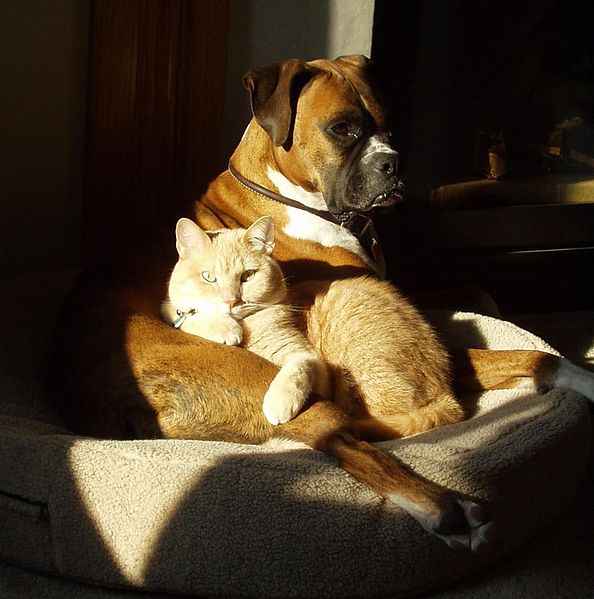 Bringing a new pet into the family or combining households each coming with their own pets can pose some interesting problems. It’s important to consider the logistics of forming relationships between pets and between people and pets before rushing them into a situation that may be strenuous for all involved. There are some easy ways to minimize or even eliminate problems during these transitions if you are willing to take take the steps necessary.
Bringing a new pet into the family or combining households each coming with their own pets can pose some interesting problems. It’s important to consider the logistics of forming relationships between pets and between people and pets before rushing them into a situation that may be strenuous for all involved. There are some easy ways to minimize or even eliminate problems during these transitions if you are willing to take take the steps necessary.
Adopting a New Friend
Whether you may be looking into adopting your first pet or bringing a new one into the family, it’s important to meet lots of candidates before deciding on the one who will fit best in your family. While you may be attracted to a specific breed or look, it is ultimately a pet’s personality that will make integration a success.
 If you already have a dog or cat or have previous experience in living with one (or more), you probably already have an idea what you’re looking for in your next companion. You probably already know what works for you as far as pet behavior and personality and what animals may be the best fit for your situation. First time pet people may have more difficulty in making the right choice and getting past the first impression they may have from a photo or first glance. Pet seekers may think that they know what they want, but may fail to understand the tendancies and potential issues that may come along with specific types of pets, and it may be hard to muster patience and understanding to get through if you’re a first-timer. As a result return rates to shelters can be as high as 20 percent, failed connections and sad endings that may have been avoided with a little more time or planning.
If you already have a dog or cat or have previous experience in living with one (or more), you probably already have an idea what you’re looking for in your next companion. You probably already know what works for you as far as pet behavior and personality and what animals may be the best fit for your situation. First time pet people may have more difficulty in making the right choice and getting past the first impression they may have from a photo or first glance. Pet seekers may think that they know what they want, but may fail to understand the tendancies and potential issues that may come along with specific types of pets, and it may be hard to muster patience and understanding to get through if you’re a first-timer. As a result return rates to shelters can be as high as 20 percent, failed connections and sad endings that may have been avoided with a little more time or planning.
The ASPCA has developed a simple and effective method for helping those ready for their next friend to find a good fit. Their Meet Your Match program begins with a personality assessment of each pet they bring in to determine each individual’s dominant traits and characteristics including friendliness, playfulness, energy level, ect. The animals are then categorized into one of nine color-coded personality types including laid-back “Couch Potatoes,” or “Go-Getter” types. The personalities are not assigned on preconceived breed notions, but on the individual. These classifications help you as a potential adopter, to meet cats or dogs with personalities who might suit you best. While you are not restricted to choose pets in your category, representatives encourage you to meet and interact with these pets first in hopes of creating a forever situation.
Be sure to consider how any current pets may feel or adapt to a new pet in the house as well.
Pulling Pets Together
 Perhaps you are adopting a second pet or maybe you’ve reached a point in your life where you will be combining households, whether through a new marriage, relationship or some other situation. Now both sides have to consider how your pet(s) will adjust to new surroundings or new entities that haven’t been in a shared space before. Some pets venture through these transitions with ease, while others can become stressed or exhibit undesireable “acting-out” behaviors you may not expect or appreciate. Take steps to ensure a smooth move and adjustment, but stay prepared for issues that may arise that could require extra attention, patience, time from the humans in the house.
Perhaps you are adopting a second pet or maybe you’ve reached a point in your life where you will be combining households, whether through a new marriage, relationship or some other situation. Now both sides have to consider how your pet(s) will adjust to new surroundings or new entities that haven’t been in a shared space before. Some pets venture through these transitions with ease, while others can become stressed or exhibit undesireable “acting-out” behaviors you may not expect or appreciate. Take steps to ensure a smooth move and adjustment, but stay prepared for issues that may arise that could require extra attention, patience, time from the humans in the house.
One of the most important first steps is to let potential housemates meet and interact in a neutral location. This helps to seed relationships without as many complications with territoriality and/or possessiveness. Dogs may be a little easier to socialize than other pets. Take the pups and the whole family to the dog park or a similar locale to meet and play, and do it several times so everybody gets to know each other. If you’re adopting, ask the shelter if you can bring your current pet(s) to meet the potential adoptee–many shelters will ask that you do othis anyway, and they often have dog runs or contained areas where the animals can interact before you bring the new pet home. Keep open communication about your pets, making sure (specifically with children) that you all know what pets like and don’t like. If your dog doesn’t like his ears touched, for example, be sure the new crew knows it to prevent any misunderstanding.
Once things seem kosher on neutral ground, give the new home a visit. It may help to remove familiar items like toys, bowls and treats from the area which may bring out some territoriality in established animals. Be watchful during these initial visits to deal with any problem behaviors. Dogs are pretty good at communicating and setting up a natural order. After a few visits the pecking order should be established and the permanent move should be pretty smooth. Be consistant in training and attention to all pets involved so the natural order isn’t upset by jealousy or competition.
Cats and other pets may not be quite as easy. Try slow introductions and be sure to give them some space to avoid each other if they want to. Remember, even if you take all the precursory steps, matches aren’t always ensured and sometimes a relationsip may never form between pets (or pets and people for that matter). Just be prepared to accommodate if they choose not to like each other, possibly even dedicating seperate spaces where they can avoid each other.
Cats Grooming image referenced from wikipedia and originally posted by Jessica Deily
Doggie Kiss image referenced from wikipedia and originally posted by Mike Baird
 That Pet Blog That Pet Place Pet Blog
That Pet Blog That Pet Place Pet Blog

Its A very good Information about Pets and People, IT can be great help to all, Thanks for the post…..
I like the way you talk about what you should do for both new pet owners and for pet owners extending their family. I think the tips that you have given are really good and may make it easier for some people when trying to integrate a pet into their lives. I like the way that you also took time to note that some pets may not get along either with other pets or with people. I think this is a really important point to make as it makes people think really hard about getting a pet before they do it and ensures it’s not a split second decision